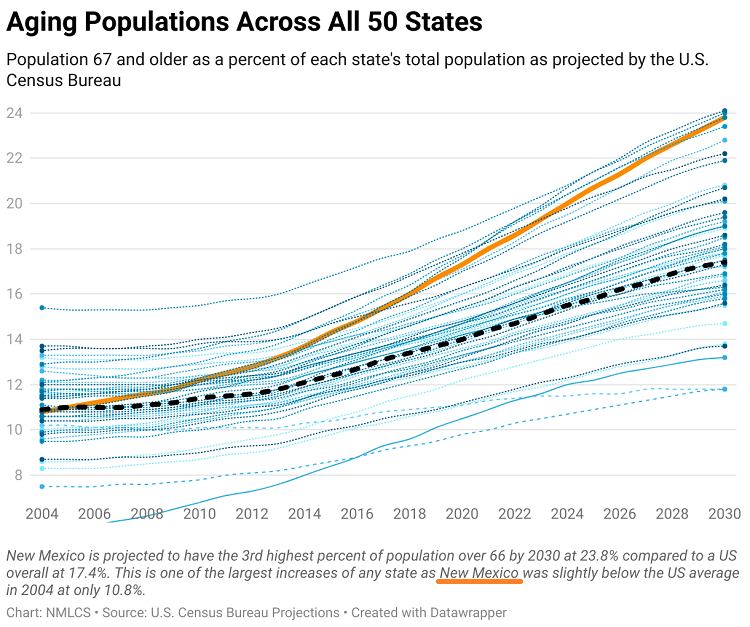As New Mexico Hemorrhages Healthcare Workers – Younger Doctors and Other Professionals Are Hesitant to Stay.
This is an introduction to the first of several stories dealing with the collective failure of UNMH, the UNM Medical School, the Governor and State legislature to address an increasing crisis of shortages of health care professionals. Today’s lead story, following this introduction, focuses on the plight of resident physicians at the University of New Mexico Hospital – and the indifference of UNM Leaders.
The Candle has requested several times over the past three weeks to interview UNM officials as well as Employee Union Officials and Resident Physicians for this series – UNM has declined, but has offered limited responses via email, while the Union and Physicians have provided interviews.)

On October 30, 2023, Senator Gerald Ortiz y Pino, Chair, and Representative Elizabeth “Liz” Thomson, Vice Chair, of the New Mexico Interim Legislative Health And Human Services Committee (LHHS) sent a letter to the University of New Mexico Hospital and Health Sciences Center Leadership. They and their colleagues were worried about shortages in the healthcare workforce and failures to retain and recruit professionals to stay in the state.
Their letter states:
“Addressing the shortage of health care professionals in New Mexico is one of our highest priorities, and we believe it is crucially important to retain the health care professionals who are already working here.”
The letter also emphasized legislators’ “support for fair compensation and treatment of physician residents working in University of New Mexico residency programs.”
Health care workforce shortages are real and about to get worse.
In less than seven years New Mexico will have the third highest percentage of residents over the age of 66.

The state also has one of the highest average age of practicing doctors – 53.
New Mexico is desperate for new doctors.
“The aging physician population reflects the difficulty New Mexico has in attracting and retaining young physicians.”
The quote above is from the study – Physician workforce in the United States of America: forecasting nationwide shortages, Published Online February 2020, which includes the following observations:
“As for physician shortage ratios (physician jobs per 100 000 people), by 2030, the three states with the most severe physician shortage ratios will be Mississippi (120), New Mexico (101), and Louisiana (100).
Legislators also wrote in their missive to UNM Hospital and UNM officials (See complete letter at end of this introduction):
“We cannot afford to lose these resident physicians to surrounding states. The average age
of a physician in New Mexico is 53, which means that New Mexico will soon lose a large
portion of the state’s already limited number of physicians to retirement.
“We have to train and retain as many resident physicians as possible to avoid an even greater shortage of physicians than we are already facing.
“If the physician workforce is not replenished, it will be nearly impossible for New Mexico residents to access the care that they need.
“Therefore, the Legislative Health and Human Services Committee encourages you to make
every reasonable effort to support your physician residents so that they leave their residency with a positive outlook on practicing in New Mexico.”
As will be detailed in the first installment of this series, given the way the leaders of the University of New Mexico Hospital and School of Medicine have treated resident physicians at the state’s “flagship” hospital, there is considerable concern that these doctors may not want to practice in New Mexico once they have completed their respective residencies.
Will the LHHS Move to Put Some Money Where their Mouths Are?”
Beginning today, the interim Legislative Health and Human Services Committee meets through the end of this week. The most recent draft of its agenda can be seen by clicking here.
While there are numerous health related items on the agenda, there is nothing specifically related to the resident physician concerns the committee raised to UNMH and UNM HSC officials at the end of last month.
However the last agenda item listed for Friday’s session is an open-ended item entitled “Consideration of Legislation for Endorsement.”
It will be interesting to see if members of the LHHS Committee are willing to put their words of concern to action by drafting and endorsing a bill that would appropriate money to supplement physician residency compensation from the projected $3.5 Billion of surplus the legislature will have to distribute in January.
Read the next installment in this series later today: